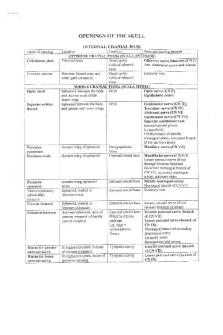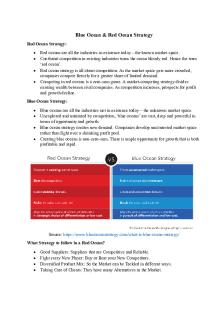Georgia O\'Keeffe\'s Cow Skull Red, White, and Blue at The Met Museum Paper PDF

| Title | Georgia O\'Keeffe\'s Cow Skull Red, White, and Blue at The Met Museum Paper |
|---|---|
| Author | Amanda Scheuer |
| Course | Introduction to Art History II |
| Institution | Rutgers University |
| Pages | 4 |
| File Size | 144 KB |
| File Type | |
| Total Downloads | 38 |
| Total Views | 156 |
Summary
Essay about Georgie O'Keeffe for Professor Glenn's Art History course....
Description
Amanda Scheuer Museum Paper Intro. Art History II January 6, 2017 Georgia O’Keeffe’s Cow’s Skull: Red, White, and Blue at The Met When artist Georgia O’Keeffe made the move to New Mexico in 1929, the subject matter of her artwork changed dramatically. The content of her works shifted from skyscrapers and the views of New York City to the nature found in the desert. This included images such as skulls and barren landscapes flooded by the dry sunlight of Santa Fe. One of the highlighted artworks
of her career at this time was her painting Cow’s Skull: Red, White, and Blue which was painted in 1931. To create this work, O’Keeffe used oil paint on canvas, which was a typical medium for her to use in her works. This artwork would be considered a still life because it depicts simply a cow’s skull against a smooth background. The subject of this painting is a jagged-edged skull with a very dull, “bleached” color, emphasizing its “worn surfaces.” It appears to be floating in front of a simple background: what looks like red, white, blue, and black draped fabric. The description of the artwork states that O’Keeffe uses these colors as a way of alluding to the strength of the American spirit. In addition, the skull is intended to symbolize the enduring beauty of the desert, which was her home until she passed away in 1986. The elements of form in this artwork that stand out most prominently are line, color, and texture, but it is also important to note the space and composition. The lines defining the shape of the skull encourage the viewer to look first at the most detailed portion, from the skull’s
midpoint to the bottom of the rugged bones. Then the viewer’s eye is guided upwards to the eye sockets of the skull, and finally to the top of the cow’s horns. Next, the lines of the wrinkled fabric come into view which also creates a kind of upward movement in the piece. The linear stripes of the colored shapes in the background are supposedly intended to symbolize the American flag, and thus, the spirit of the American west. The colors, which I mentioned previously, include an array of earthy hues in the skull, which are offset by the bold reds and blues behind it. The different values of color in the skull help to convey the depth; for instance, a darker grey is used to indicate the holes of the eye sockets. While the colors in the skull are less intense, the background colors are very saturated in order to dramatically contrast the two. The texture of the painting stands out almost immediately; although O’Keeffe uses the smooth medium of oil paint, she demonstrates the rough and jagged surface of the skull. To contrast the main subject, her background consists of a very soft, sleek, flowing drapery. In addition, as stated previously, the skull appears to be floating in the air in the center of the fabric behind it. The composition, or organization of the items in the painting, is another important aspect of the movement because it directs the viewer’s gaze first to the cow’s skull. The way the blue material opens up to envelop the skull is another way O’Keeffe emphasizes the importance of this ascending symbol of enduring beauty. Georgia O’Keeffe’s art style is unique and unmistakable, and that style is evident in this painting as well. Although she has some works that seem to be more abstract, such as her close-ups of flowers and landscapes, this piece is definitely representational. This is because the subject matter, as in the cow’s skull, is easily recognizable; it is not altered or distorted in any way. The symbol of the American flag in the background may be considered somewhat abstract,
however, but the painting as a whole is representational for the most part. Also, this painting may exhibit dominating highlights and shadows, but the style is certainly more linear than it is painterly. This is because the artwork is clearly dominated by the lines that define the shapes of the skull and the symbolic American flag. Furthermore, I would classify this painting by O’Keeffe as naturalistic because the nature of the cow’s skull in the desert is her primary inspiration for this piece. It does indeed resemble the what a real cow’s skull would look like, but her style comes through in order to take away from the literalness and exactitude of reality. Not to mention, the fabric draped behind the skull strives to add more to the style and symbolism of the artwork than it adds to the realism. To conclude, the style of this painting can be described as a mostly representational, linear, and naturalistic portrayal of a cow’s skull against a red, white, blue, and black drapery. One artwork that stood out to me during the lectures was the famous Mona Lisa by Leonardo da Vinci, which was painted in the early 16th century. At first glance, these paintings do not have much in common. They were painted within hundreds of years of each other, in very different geographical locations - United States and Italy - and the subject matter of each is incredibly distinct. Da Vinci’s Mona Lisa depicts a mysterious smiling woman, of unknown identity, against a complex, mountainous landscape. On the other hand, O’Keeffe’s painting depicts a cow skull against a simple, colorful background. In addition, Cow’s Skull would be considered a still life painting, while Mona Lisa is clearly a portrait. Although these two paintings are incredibly different, I would like to make note of some of the similarities between them. The first characteristic that comes to mind is the
composition of the central figure, which the viewer is drawn to upon first glance, that is posed in front of a colorful background. Of course, the landscape behind the Mona Lisa is more realistic than the colorful fabric behind O’Keeffe’s skull, but the background in both paintings is more vibrant than the main subject matter. Likewise, the use of a strong gradation of light and shadow is very noticeable between these two artworks. Mona Lisa is known for its incredible use of chiaroscuro, which is also found in the details and surfaces of O’Keeffe’s skull. The form of these paintings are comparable as well, specifically the line and texture. In each painting, there is a clearly defined shape, a woman and a skull, that are enclosed by distinct lines. Because both paintings were created with oil paint, a similar texture is achieved. Da Vinci’s Mona Lisa is very smooth, and her skin looks almost like porcelain, but the background is very rigid and coarsely textured. O’Keeffe’s Cow’s Skull consists of a very smooth background, and parts of the skull are very porcelain or polished looking as well. Nevertheless, the irregular, jagged edges of the bottom of the skull are comparable to the harsh background behind Mona Lisa. There is another comparison to note with the subject versus the background in these two artworks. Mona Lisa utilizes the repetition of winding roads in the background to parallel the curvy drapery on her figure, whereas O’Keeffe’s skull uses very solid, linear edges in the skull to complement the straight lines of color behind it. Additionally, the styles are very similar; I would consider both paintings to be representational, linear, and naturalistic. Mona Lisa is a realistic representation of a woman posing for a portrait, it uses clearly defined lines, and nature is the primary inspiration for this piece. Even though I wouldn’t have initially put these two paintings together, I was able to find many significant similarities based on what we have learned thus far in the lectures....
Similar Free PDFs

Museum Term Paper - ART101
- 5 Pages

Sunset grill at blue
- 13 Pages

Art History Museum paper
- 12 Pages

Openings of the skull
- 5 Pages

Ethereum white paper
- 33 Pages

White Paper Rubric
- 1 Pages

SDN & IBN White Paper
- 10 Pages

THE British Museum - summary
- 3 Pages
Popular Institutions
- Tinajero National High School - Annex
- Politeknik Caltex Riau
- Yokohama City University
- SGT University
- University of Al-Qadisiyah
- Divine Word College of Vigan
- Techniek College Rotterdam
- Universidade de Santiago
- Universiti Teknologi MARA Cawangan Johor Kampus Pasir Gudang
- Poltekkes Kemenkes Yogyakarta
- Baguio City National High School
- Colegio san marcos
- preparatoria uno
- Centro de Bachillerato Tecnológico Industrial y de Servicios No. 107
- Dalian Maritime University
- Quang Trung Secondary School
- Colegio Tecnológico en Informática
- Corporación Regional de Educación Superior
- Grupo CEDVA
- Dar Al Uloom University
- Centro de Estudios Preuniversitarios de la Universidad Nacional de Ingeniería
- 上智大学
- Aakash International School, Nuna Majara
- San Felipe Neri Catholic School
- Kang Chiao International School - New Taipei City
- Misamis Occidental National High School
- Institución Educativa Escuela Normal Juan Ladrilleros
- Kolehiyo ng Pantukan
- Batanes State College
- Instituto Continental
- Sekolah Menengah Kejuruan Kesehatan Kaltara (Tarakan)
- Colegio de La Inmaculada Concepcion - Cebu







